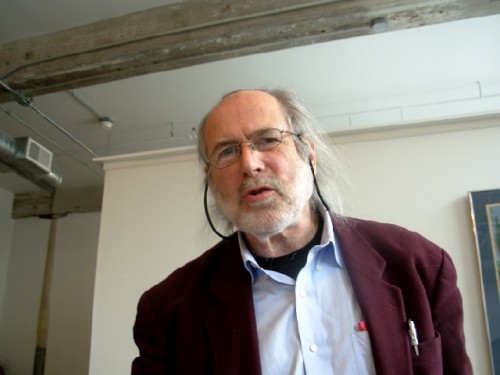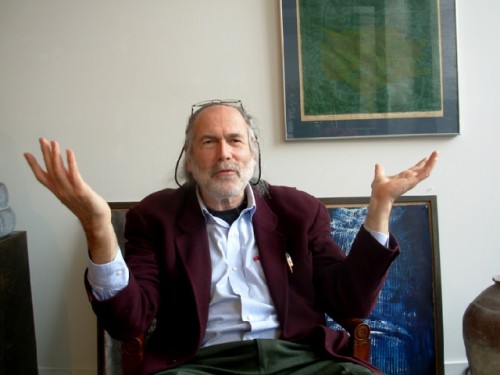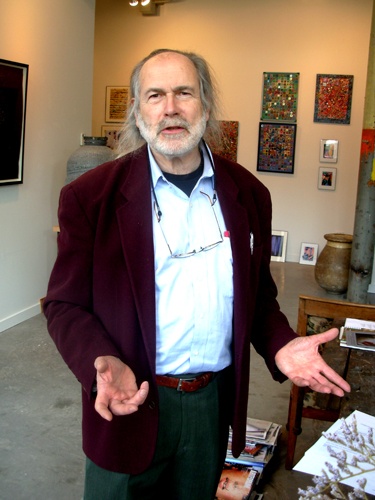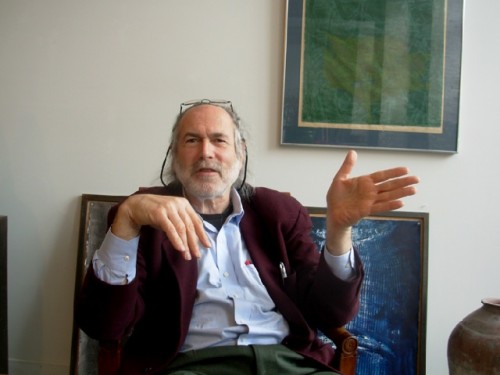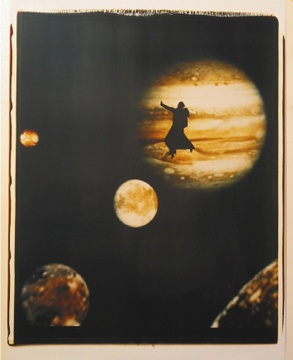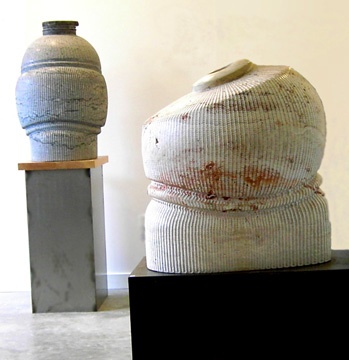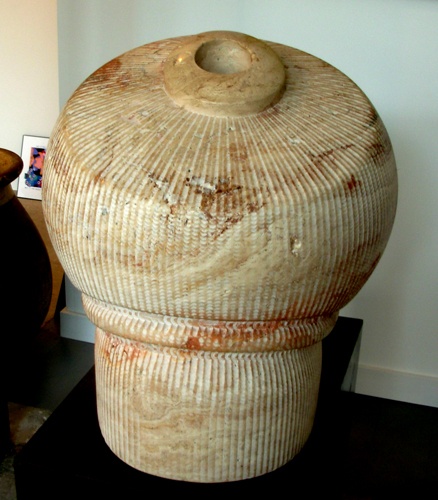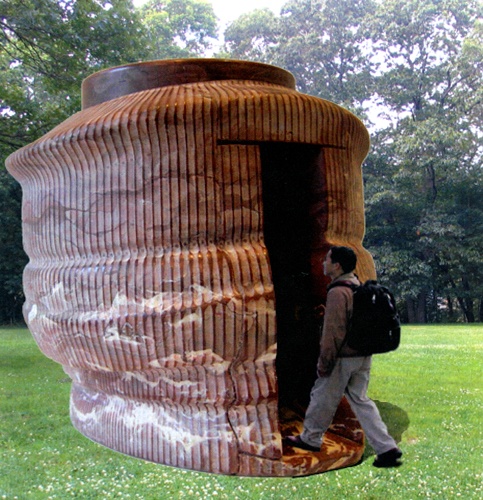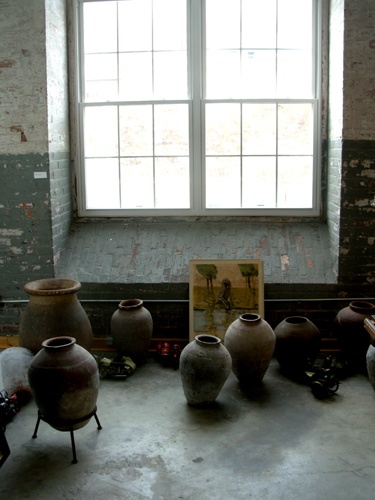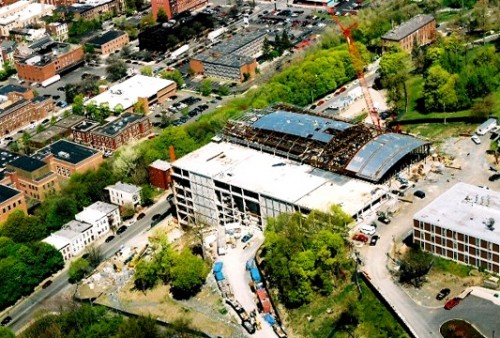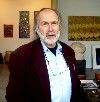North Adams Artist: Ralph Brill
Eclipse Mill Based Gallerist Discusses Visionary Plans
By: Charles Giuliano - Jan 28, 2008
Seated in the first floor loft of the Ralph Brill Gallery, at 243 Union Street, in North Adams he stated that "I have given myself three years" to explore the viability of a business plan "and I am now a year and a half in." While many in the arts are frustrated by incremental progress in the goal of establishing a viable and vibrant arts community in the Northern Berkshire County, Brill, who has thought long and hard about the issue, sees a turn around in approximately five years.
For many artists, and under the radar arts organizations, there may not be sufficient resources to hold on that long. As we head into a recession there is a particularly devastating impact on the arts community. Too often artists and arts organizations fit the profile of "last to get hired and first to get fired." It is particularly hard for the young and single to make a go of living in the Berkshires. The odds are better for couples and retired folks who settle here with resources. Brill noted how many former CEOs and alumni retire in nearby Williamstown.
"There are at least ten to twelve, world class events- lectures, concerts, performances, exhibitions- which occur annually in the Northern Berkshires" Brill said. He gave as an example the lecture last week at the Clark by Philippe de Montebello, retiring director of the Metropolitan Museum of Art, which was free and well attended. He is on the road much of the week and returns to North Adams on Friday leaving generally on Monday unless there is a special event mid week. "I check out the listings in the Advocate and there is always something quite wonderful happening at the Clark, Mass MoCA, or Williams College. Most of these events are free or offered for a nominal amount. Those same events in New York City would cost $250 per ticket or be sold out."
He also observed that mostly these events are attended by seniors. All of the Berkshire arts organizations discuss and try to come up with strategies to expand their demographics. Developing young audiences is crucial for sustaining the arts.
While it is easy to gripe, and talk is cheap, Brill is one of the handful of individuals who is really doing something. In addition to running a gallery, he is a trained architect who is planning a public art project to illuminate the Hoosic River from the Eclipse Mill to Mass MoCA. He also discussed with me plans to launch a World War II Museum of the Arts (Europe, U.S and Asia) in North Adams. It would be the area's Fourth Museum adding another potential 100,000 annual visitors. This in addition to the extra 30,000 annually who are expected to visit Mass MoCA, starting next November, when it opens a new building devoted to an installation of site specific works by the late Sol LeWitt.
Mass MoCA draws an average of 125,000 visitors which was down last summer because of the botched Christoph Buchel project. They should be back on track with the successful Jenny Holzer installation. So their numbers should expand to 150,000 with the added LeWitt attraction. While the Clark averages 160,000 they should see an increase this summer with the opening of a building designed by Tadeo Ando. Brill and his associates are projecting a soft launch of the World War II Museum with 5,000 square feet initially expanded to 20,000 square feet when it takes hold. These growing numbers underscore why he suggests a five year time frame for economic growth and development .
After the Hairpin Turn on the Mohawk Trail most drivers on Route Two just blast through North Adams, perhaps with a quick detour to Mass MoCA, then on to Williamstown ending in Troy, New York. Before the creation of the Mass Pike the old Route Two was the main axis connecting mills in Troy and North Adams with Boston. Brill discussed ideas for revitalizing that axis creating cultural synergy between North Adams, Williamstown, and Troy.
"By the time people arrive here" Brill said. "They are exhausted. It is generally afternoon or late in the day and they have time for the Clark or Mass MoCA, one or the other, and that is pretty much it. Or if they are driving through in the winter, on the way to ski country, they want to hit the slopes. Last year there was no snow for much of the winter so people were coming in to see the Eclipse Mill. They found it interesting and many indicated that they would return in the summer. In the Vermont ski towns there is a lot of business in the shops and I think we have to do more to reach that audience."
Changing pace I asked for some vital statistics. He seemed reluctant to get into that. When I asked for a resume, for example, the response was "the past is the past." Now 63, he was born on November 24, 1944 in Cheltenham, England, north of London. The family relocated to the U.S. when he was five. He studied architecture at the University of Illinois with graduate study in Urban Planning in Denmark. He had his own firm Brill, Kawakami, Wilbourne, which specialized in solar and wind energy projects. The firm had a studio in New York City, Cold Springs, New York and Telluride, Colorado. With a general downturn of the economy the firm closed in 1990.
"I wanted to move on to other things" he said. "For a time, I had a farm in Vermont that raised organic cattle. I was commuting to a studio in upstate New York so North Adams seemed like a good mid point."
Part of his lifestyle entails constant movement which included time divided between New York and Colorado when the firm was active. "My kids (three) grew up relating to me that way. I have a great relationship with them. They have come to my openings and made friends in the mill. This week one is hiking in Patagonia, one is skiing in Utah, and one will be attending Fashion Week in New York on Friday " he said. Brill divorced ten years ago. I asked for him to describe a typical week. There are weekends in North Adams. Two days are spent intensively writing in New York on two book projects for which he has publishers. One is a catalogue of Hudson River painting and the other entails Civil War canons. Two days a week he spends in Putnam County, New York where he does consulting on medical devices and uses of ethanol. One day a week he is in New York City to see things and meet with friends. He described a visit to the New Museum and its recently opened building but found the initial exhibition compared poorly to what is exhibited at Mass MoCA.
There is also a small, two bedroom, stone house built in the 1500s, in the midst of an olive grove in Cortona, Italy when he "wants to truly get away from it all. I try to be there for a week, three or four times each year. It is about an hour from Florence between Sienna and Perugia. So I can go and see magnificent things. It is heavenly and I enjoy great food and wine."
How and why does he maintain such a peripatetic lifestyle? "I don't know any other way" he said. "I have real work to do. There are a lot of projects I am developing and no one place has the space for all of my activities. This afternoon, for example, I have this pile of magazines to get through."
Which is why he is quite suited to the irregular pattern of traffic to his gallery. When there are visitors, which was the case a couple of times during our meeting, he is a cordial greeter, willing to answer questions and discuss the works on view. He generally plans only three or four exhibitions each year and represents established artists. Rather than selling individual pieces, he presents bodies of work to major institutions, and is involved with large projects.
"I didn't intend this as a retail shop" he explained. "If that was my plan I would have found a space on the main drag in Lenox or Williamstown. That is not my main interest or I would have opened a storefront with a picture window and sold safe landscapes. That seems to be what works here. I do plan to show landscapes at some point but they will be Hudson River paintings with a mix of historic and contemporary interpretations."
This year he has shown Eve Sonneman, who exhibited at the Museum of Modern Art in the 1970s, and was represented by the prestigious Leo Castelli Gallery. He represents her patterned abstract paintings as well as the small number of large format Polaroid prints that she makes each year. She is one a few artists allowed access to the unique Polaroid studio.
Yes, there have been sales of her work. From time to time he is asked to visit homes in the Berkshires interested in a Sonneman painting. Too often it does not fit the space and décor of Victorian era homes with small rooms and dark paneled walls. "These are people who go to Mass MoCA and love the work but find that they can't live with it."
In a corridor space of the gallery he discussed a series by the Magnum photographer, Leonard Freed, who died not long after Brill began to represent him. The images were selected by the Smithsonian from a project looking at African Americans during the time of the Civil Rights movement but not in the manner that they were represented by most photo journalists. Freed focused on aspects of everyday life including studies of blacks in prisons, kids on the street, or juxtapositions of blacks and whites with an emphasis on social disharmony. Several works from the series were borrowed by the Smithsonian, framed, widely exhibited, and eventually returned to the artist. Brill, according to the wishes of the artist, is in the process of selling them as a group to a major museum. He is one of three resources, including Magnum, for those seeking prints by Freed for which there is a lively market. Prices have increased by 25% in the past year.
He also represents the sculpture of Jon Isherwood of which he displays a few, small scale, works in the gallery. They take on average a year and a half to create but the artist is working on a number of pieces at the same time. They are subtracted from Champlain Marble which is a black material found on a specific island in Lake Champlain in upstate New York. The original blocks range from small chunks to boulders as "large as a VW." These are then transported to the studio in Princeton, New Jersey where the meticulous, signature grooves are calculated and carved using computers. In the process the artist makes clay sketches, then plaster models, leading up to lines drawn directly onto the stone.
While the small works or maquettes are displayed in the North Adams gallery again Brill is involved in large scale projects. There is current negotiation with an individual from Lenox to create a Holocaust Memorial somewhere in the Berkshire woods. It would be a carved out meditation chamber. If the project goes forward it will cost between $500,000 and $750,000.
Having a project come through on that level does not require the constant foot traffic of a retail space. But the cultural mix of the area increases the odds of attracting that level of curator or collector. The top players constantly stream through the Clark and Mass MoCA. The trick is to find a way to divert that traffic to other locations.
During a recent meeting of the Eclipse Mill Gallery Committee, for example, Brill demonstrated that the Eclipse does not appear on the widely distributed visitor's map. But the mill across the street, for whatever reason, is depicted. That now vacant space is under development. Typically, Ralph came to the meeting with lots of energy and ideas. One of the projects he and the potters Gail and Phil Sellers propose is an exhibition of historic photos and documents related to the former industrial life of the Eclipse Mill. They are proposing putting out a general call for people to search through family albums and attics for suitable memorabelia. To come forth and tell their stories.
There is another project he has been working on for a couple of years which may occur this April, subject to final approvals. He is calling aesthetic attention to the Hoosic River which starts in Vermont and runs through North Adams. Depending on location it is known as Hoosac, Hoosic or Hoosick. It was this source of energy which powered the mills. But there were numerous floods which caused enormous damage. In the 1950s the Army Corps of Engineers constructed a channel which starts at the Eclipse Mill and runs past Mass MoCA after which it becomes a natural river which extends on to Hoosick Falls in New York from which it drops down into the Hudson River.
To celebrate the river and its symbolic importance Brill is working on the "Hoosac River Lights" project. He plans to illuminate a section of the river between the Eclipse and Mass MoCA which will be visible from the vast, city owned, parking lot behind Big Y in the North Adams shopping mall. It will also be visible from The Porches Inn. If the project comes through he would like to show the sketches and plans in the Eclipse Gallery.
"If it succeeds it will be a beautiful experience" he said. "When I went to the Mayor (John Barrett III) he told me that it would take at least a year to get the approval of the Army Corps of Engineers. I said that I had already done that and he is very excited about supporting the project. I am working with a group of students from the Rensselaer Polytechnic Institute (RPI) in Troy and we intend to use LEDs that can be placed under water. It would be great to have this as an annual event open to an ongoing series of light artists."
Brill spoke about the enthusiasm he has for RPI and the changes that are occurring in Troy. He urged us to take the hour drive to see the soon to open $200 million Experimental Media and Performing Arts Center (EMPAC) which he predicts will be as much a destination for architectural tourism as the Bilbao Guggenheim designed by Frank Gehry. The 203,000 square foot, state of the art, performance facility, designed by Nicholas Grimshaw, features built in, multi media capabilities.
"Troy used to be one of the richest cities in America, back in the 1820s, based on the traffic along the Erie Canal. It was a center for innovation. The RPI campus, with its 5,000 students, sits on a hill overlooking the city" Brill said. There is the start of a dialogue about creating synergy between Troy and North Adams along a Route Two cultural axis. Brill is one of the initiators of that process.
We had been talking for some time when Brill brought up plans for developing a World War II Museum of the Arts (Europe, U.S., Asia) in or near North Adams. He mentioned the support of Senator Kennedy and the interest of RAA Architects the designers of the Holocaust Museum in Washington D.C. He alluded to a local collector with a vast resource of material among many that are being considered. Then, "speak of the devil" in walked Darrell K.T. English. But it is a topic for another day.
By now I was worn out trying to keep up with Brill, his peripatetic lifestyle and thinking process. There was a lot to chew on. Truly, he is a remarkable resource. Even if just a few of his many ideas and projects come to fruition Brill will leave an indelible mark on the arts of the Northern Berkshires.
http://www.brillgallery109.com/

